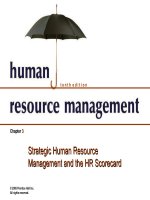Dessler HRM 12e ch 017 managing global HR
Bạn đang xem bản rút gọn của tài liệu. Xem và tải ngay bản đầy đủ của tài liệu tại đây (557.27 KB, 29 trang )
Chapter 17
Managing Global
Human Resources
Part Five | Employee Relations
Copyright © 2011 Pearson Education, Inc.
publishing as Prentice Hall
PowerPoint Presentation by Charlie Cook
The University of West Alabama
WHERE WE ARE NOW…
Copyright © 2011 Pearson Education, Inc. publishing as Prentice Hall
17–2
LEARNING OUTCOMES
1. List the HR challenges of international business.
2. Illustrate with examples how intercountry differences
affect HRM.
3. List and briefly describe the main methods for staffing
global organizations.
4. Discuss some important issues to keep in mind in
training, appraising, and compensating international
employees.
5. Explain with examples how to implement a global
human resource management program.
Copyright © 2011 Pearson Education, Inc. publishing as Prentice Hall
17–3
HR and the Internationalization of
Business
• The Global Challenges
Coordinating market, product, and
production plans on a worldwide basis
Creating organization structures capable
of balancing centralized home-office
control with adequate local autonomy
Extending HR policies and systems
to service staffing needs abroad
Copyright © 2011 Pearson Education, Inc. publishing as Prentice Hall
17–4
Challenges of International HRM
• Deployment
Getting the right skills to where they are needed,
regardless of geographic location
• Knowledge and Innovation Dissemination
Spreading state-of-the-art knowledge and
practices throughout the organization regardless
of their origin
• Identifying and Developing Talent
on a Global Basis
Identifying those who can function effectively in a
global organization and developing their abilities
Copyright © 2011 Pearson Education, Inc. publishing as Prentice Hall
17–5
Intercountry Differences Affecting
HRM
Cultural factors
and ethics issues
Political/Legal
systems
International
Human Resource
Management
Economic
systems
Labor
relations
Copyright © 2011 Pearson Education, Inc. publishing as Prentice Hall
17–6
Global Differences and Similarities
in HR Practices
Personnel
selection
procedures
Use of pay and
other incentives
International
HRM
Purpose of
performance
appraisal
Training and
development
practices
Copyright © 2011 Pearson Education, Inc. publishing as Prentice Hall
17–7
Staffing the Global Organization
• International staffing: Home or local?
Expatriates (expats)
Home-country nationals
Third-country nationals
• Offshoring
Having local employees abroad do jobs that the
firm’s domestic employees previously did in-house
• Offshoring Issues
Effective local supervisory/management structure
Screening and required training for locals
Local compensation policies and working conditions
Copyright © 2011 Pearson Education, Inc. publishing as Prentice Hall
17–8
Management Values and
International Staffing Policy
Top Management Values
Ethnocentric
Polycentric
Copyright © 2011 Pearson Education, Inc. publishing as Prentice Hall
Geocentric
17–9
Selecting Expatriate Managers
• Adaptability Screening
Assessing the assignee’s (and spouse’s)
probable success in handling the foreign transfer.
Overseas Assignment Inventory
A test that identifies the characteristics and
attitudes international assignment candidates
should have.
• Realistic Previews
Cover problems to expect in the new job, as well as
the cultural benefits, problems, and idiosyncrasies
of the country.
Copyright © 2011 Pearson Education, Inc. publishing as Prentice Hall
17–10
FIGURE 17–2
Five Factors Important in International Assignee Success
and Their Components
I. Job Knowledge and Motivation
Managerial ability
Organizational ability
Imagination
Creativity
Administrative skills
Alertness
Responsibility
Industriousness
Initiative and energy
High motivation
Frankness
Belief in mission and job
Perseverance
II. Relational Skills
Respect
Courtesy
Display of respect
Kindness
Empathy
Nonjudgmental
Integrity
Confidence
Copyright © 2011 Pearson Education, Inc. publishing as Prentice Hall
III. Flexibility/Adaptability
Resourcefulness
Ability to deal with stress
Flexibility
Emotional stability
Willingness to change
Tolerance for ambiguity
Adaptability
Independence
Dependability
Political sensitivity
Positive self-image
IV. Extracultural Openness
Variety of outside interests
Interest in foreign cultures
Openness
Knowledge of local language(s)
Outgoingness and extraversion
Overseas experience
V. Family Situation
Adaptability of spouse and family
Spouse’s positive opinion
Willingness of spouse to live abroad
Stable marriage
17–11
FIGURE 17–3
Overseas Assignment
Inventory
Copyright © 2011 Pearson Education, Inc. publishing as Prentice Hall
17–12
Inability of spouse
to adjust
Personality of
expatriate
Personal
intentions
Why Expatriate
Assignments
Fail
Family
pressures
Copyright © 2011 Pearson Education, Inc. publishing as Prentice Hall
Inability to cope
with overseas
responsibilities
Lack of cultural
skills
17–13
Making Expatriate Assignments
Successful
Realistic previews
Careful screening
Helping
Expatriate Assignments
Succeed
Improved orientation
Cultural and language
training
Improved benefits package
Copyright © 2011 Pearson Education, Inc. publishing as Prentice Hall
17–14
Orienting and Training Employees
on International Assignment
• Predeparture training is needed on:
The impact of cultural differences on
business outcomes
How attitudes (both negative and positive)
are formed and how they influence behavior
Factual knowledge about the target country
Language and adjustment and adaptation skills
Copyright © 2011 Pearson Education, Inc. publishing as Prentice Hall
17–15
Trends in Expatriate Training
• Use of returning managers as resources to cultivate
the “global mind-sets” of their home-office staff.
• Use of software and the Internet for cross-cultural
training.
• Rotating assignments that permit professional growth.
• Management development centers where executives
hone their overseas skills.
• Classroom programs provide overseas executives with
educational opportunities similar to stateside programs.
• Continuing, in-country cross-cultural training.
Copyright © 2011 Pearson Education, Inc. publishing as Prentice Hall
17–16
Compensating Expatriates
• The “Balance Sheet Approach”
Home-country groups of expenses—income taxes,
housing, goods and services, and discretionary
expenses—are the focus of attention.
The employer estimates what each of these four
expenses is in the expatriate’s home country,
and what each will be in the host country.
The employer then pays any differences such
as additional income taxes or housing expenses.
Copyright © 2011 Pearson Education, Inc. publishing as Prentice Hall
17–17
TABLE 17–1
The Balance Sheet Approach (Assumes U.S. Base Salary of $80,000)
Annual Expense
Housing & utilities
Chicago, U.S.
Brussels, Belgium
(US$ Equivalent)
Allowance
$35,000
$67,600
$32,600
6,000
9,500
3,500
Taxes
22,400
56,000
33,600
Discretionary income
10,000
10,000
$73,400
$143,100
Goods & services
Total
Copyright © 2011 Pearson Education, Inc. publishing as Prentice Hall
0
$69,700
17–18
Incentives for International
Assignments
• Foreign Service Premiums
Financial payments over and above regular
base pay, and typically range between 10%
and 30% of base pay
• Hardship Allowances
Payments to compensate expatriates
for exceptionally hard living and working
conditions at certain foreign locations
• Mobility Premiums
Lump-sum payments to reward employees
for moving from one assignment to another
Copyright © 2011 Pearson Education, Inc. publishing as Prentice Hall
17–19
Steps in Establishing a Global Pay System
1
Develop a global compensation philosophy framework.
2
Identify any gaps in existing rewards systems.
3
Systematize pay systems worldwide.
4
Adapt global pay policies to local conditions.
5
Conduct an ongoing pay policies program assessment.
Copyright © 2011 Pearson Education, Inc. publishing as Prentice Hall
17–20
Appraising Expatriate Managers
• Challenges
Determining who should appraise the manager.
Deciding on which factors to base the appraisal.
• Improving the Expatriate Appraisal Process
1. Stipulate the assignment’s difficulty level, and
adapt the performance criteria to the situation.
2. Weigh evaluation more toward on-site manager’s
appraisal than toward that of the home-site
manager.
3. If home-office manager does appraisal, use a former
expatriate from same overseas location for advice.
Copyright © 2011 Pearson Education, Inc. publishing as Prentice Hall
17–21
International Labor Relations
Characteristics of European
Labor Relations
Industry-wide
centralization
Employer
organization
Copyright © 2011 Pearson Education, Inc. publishing as Prentice Hall
Multiple union
recognition
Content and
scope of
bargaining
17–22
Terrorism, Safety, and Global HR
• Taking Protective Measures
Crisis management teams
Intelligence services
• Kidnapping and Ransom (K&R) Insurance
Crisis situations
Kidnapping: employee is a hostage
until employer pays a ransom
Extortion: threatening bodily harm
Detention: holding employee without
any ransom demand
Threats to property or products unless
employer makes a payment
Copyright © 2011 Pearson Education, Inc. publishing as Prentice Hall
17–23
Repatriation: Problems and
Solutions
• Problem
Making sure that the expatriate and his or her family
don’t feel that the company has left them adrift.
• Solutions
Match the expat and his or her family with
a psychologist trained in repatriation issues.
Make sure the expat always feels “in the loop”
with what’s happening back at the home office.
Provide formal repatriation services when
the expat returns home.
Copyright © 2011 Pearson Education, Inc. publishing as Prentice Hall
17–24
How to Implement a Global HR
System
• Best practices in developing worldwide
human resource policies and practices:
Form global HR networks that make local HR
managers a part of global teams.
Remember that it’s more important to
standardize ends and competencies than
specific methods.
Copyright © 2011 Pearson Education, Inc. publishing as Prentice Hall
17–25









